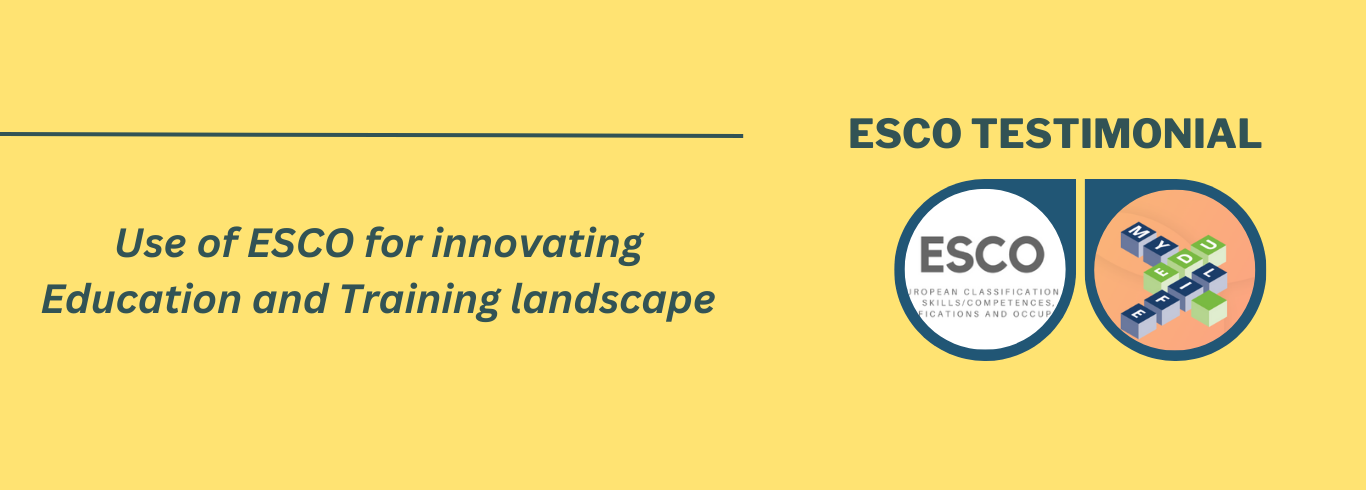MyEduLife Project using ESCO for improved Vocational Training transparency and comparability
ESCO testimonials

The following testimonial is part of a series of interviews conducted by the Commission with ESCO implementers. Their purpose is to shed a light on ESCO strengths and challenges as perceived by implementers, so that current and potential future stakeholders can gain a better knowledge on the use of ESCO. In this testimonial, MyEduLife project will be presented and how ESCO has been integrated into its framework to enhance vocational education and training transparency and comparability, providing valuable insights into the practical application of ESCO in educational settings.
Tell us a bit more about your organisation.
MyEduLife is a research and development project funded by the German Federal Ministry of Education and Research for the period spanning from 2021 to 2024. The project is conducted by research institutions such as TUD Dresden University of Technology, RWTH Aachen University and TH Lübeck University of Applied Sciences. Additionally, three testing institutions from the realms of commerce, crafts and electronics, along with the learning technologies service provider Bildungsportal Sachsen GmbH, form an integral part of this project.
The primary aim of MyEduLife is to enhance the landscape of further education and training by issuing Verifiable Credentials that clearly state learning outcomes in a standardized language through the use of ESCO.
How do you leverage ESCO in your services and since when are you using it?
The integration of ESCO in MyEduLife and all related services started in 2022. Each Verifiable Credential issued in MyEduLife contains information about the learning content and learning outcomes using ESCO. The testing institutions manually selected and identified ESCO skills that matched with their courses in the online catalogue. Additionally, they applied an AI-based service developed at TH Lübeck, resulting in a list of 15 – 75 ESCO concepts that matched to their courses. The variability in this range is due to the fact that the exact number of relevant ESCO concepts may vary based on the specific requirements or nature of each course, showcasing the adaptability of the system.
What were some of the challenges you encountered in implementing ESCO?
The matching of ESCO skills with course descriptions gave mixed results, depending on the type of qualifications and subjects covered in the learning outcomes. ESCO concepts have in fact different levels of granularity, and in some cases resulted in broader or narrower matches. This required testing institutions to invest more time in the research and curation of the list of ESCO concepts that will be included in the verifiable credentials.
What is the key ingredient in ESCO that made you take the decision to use it in your system?
The crucial aspect of ESCO lies in its open and machine-readable data, facilitating easy access and processing in our verifiable credentials. It is a stable taxonomy that enables users to showcase their skills and competences in all European languages. The use of a standardized language for presenting learning outcomes will help to create a better comparability and permeability in the Vocational Education and Training (VET) system.
What was the level of acceptance by your partners/other national stakeholders?
The testing institutions recognize the utility of ESCO in enhancing the transparency and comparability of courses outcomes for their customers. However, further improvements to the content of the classification are needed to use ESCO for all of types of courses and extend ESCO use to the entire course program.
What are some of your recommendations for other stakeholders looking to implement ESCO in their system?
As previously mentioned, and proved in our project, using ESCO proves helpful to support the matching process via AI-based systems and subsequently curate those results with experts. Testing institutions should be encouraged to gradually implement this approach. We suggest starting with a subset of their courses instead of introducing the system all at once, to prevent demotivation.
How has ESCO helped your organisation? What are its advantages and disadvantages from your standpoint?
The use of ESCO in testing institutions prompted them to reevaluate the content of their certificates. They reflected on the use of learning outcomes and their presentation in the certificates. Moreover, reflection has been conducted as well on the appropriateness of assessments to integrate this information into the certificates. In the future, the use of ESCO in VET credentials should support skills monitoring, providing insights into the work skills achieved in VET. At the moment, ESCO is not yet widespread enough to realise its potentials and efforts. To incorporate ESCO into various educational contexts could be crucial for unlocking its broader benefits. Further promotion of the classification into various education settings should be therefore a central element of the ESCO communication strategy.
In the following links you can find more information about MyEduLife project:
- Website of the project (German language): https://myedulife.de/
- Paper about ESCO usage (English language): https://doi.org/10.5334/uproc.117
- Report on ESCO usage (German language): https://doi.org/10.58926/orp.2023.2.9
